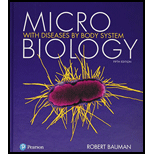
Concept explainers
Why should cardiac nurses and respiratory therapists care about biofilms?
To tell:
The reason why the respiratory therapists and cardiac nurses care about the biofilms.
Introduction:
Biofilm is the key residence of microbes in nature. Certain molecules that are secreted by the bacteria can be detected by other bacteria. Biofilms are formed by the adhesion of bacterial community to various surfaces, like the human body, metals, and soil particles. The bacterial cell is surrounded by a gelatinous layer known as a capsule. It is irregular in nature. These structures are useful for the bacteria for their attachment to the surfaces. The dental plaque in human is an example of biofilm.
The microbial cells within the biofilm matrix yield the components of extracellular polysaccharide substances, in short EPS. The EPS consist of proteins, polysaccharides, and deoxyribose nucleic acid (DNA).
Explanation of Solution
The dental plaque is an example of biofilm formation. This can cause bacterial infections like septicemia, which harm the cardiovascular system. If the medical equipments are not sterilized properly, the biofilm remains alive on them. Unsterilized pacemakers can result in recurring infections. Unclean nebulizers and oxygen supplies may harbor biofilms, which lead to infections (cystic fibrosis) in the respiratory tracts. Generally, the patients have a suppressed immune system. Therefore, they are easily susceptible to infections. Hence, the respiratory therapists and cardiac nurses should care about the biofilms.
The respiratory therapists and cardiac nurses should care about the biofilms to safeguard the patients from infections.
Want to see more full solutions like this?
Chapter 6 Solutions
Microbiology with Diseases by Body System (5th Edition)
- Noggin mutation: The mouse, one of the phenotypic consequences of Noggin mutationis mispatterning of the spinal cord, in the posterior region of the mouse embryo, suchthat in the hindlimb region the more ventral fates are lost, and the dorsal Pax3 domain isexpanded. (this experiment is not in the lectures).a. Hypothesis for why: What would be your hypothesis for why the ventral fatesare lost and dorsal fates expanded? Include in your answer the words notochord,BMP, SHH and either (or both of) surface ectoderm or lateral plate mesodermarrow_forwardNot part of a graded assignment, from a past midtermarrow_forwardNot part of a graded assignment, from a past midtermarrow_forward
- please helparrow_forwardWhat does the heavy dark line along collecting duct tell us about water reabsorption in this individual at this time? What does the heavy dark line along collecting duct tell us about ADH secretion in this individual at this time?arrow_forwardBiology grade 10 study guidearrow_forward
- Basic Clinical Lab Competencies for Respiratory C...NursingISBN:9781285244662Author:WhitePublisher:Cengage
- Essentials Health Info Management Principles/Prac...Health & NutritionISBN:9780357191651Author:BowiePublisher:Cengage
 Comprehensive Medical Assisting: Administrative a...NursingISBN:9781305964792Author:Wilburta Q. Lindh, Carol D. Tamparo, Barbara M. Dahl, Julie Morris, Cindy CorreaPublisher:Cengage Learning
Comprehensive Medical Assisting: Administrative a...NursingISBN:9781305964792Author:Wilburta Q. Lindh, Carol D. Tamparo, Barbara M. Dahl, Julie Morris, Cindy CorreaPublisher:Cengage Learning





